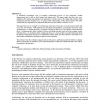Free Online Productivity Tools
i2Speak
i2Symbol
i2OCR
iTex2Img
iWeb2Print
iWeb2Shot
i2Type
iPdf2Split
iPdf2Merge
i2Bopomofo
i2Arabic
i2Style
i2Image
i2PDF
iLatex2Rtf
Sci2ools
ETS
2000
IEEE
2000
IEEE
Conferencing in communities of learners: examples from social history and science communication
A commonly encountered view of computer conferencing focuses on peer interaction, student empowerment and a shift in both teacher and student roles. This paper argues that this view overemphasises the medium and minimises the importance of factors such as the setting and structure of the conferencing and the discipline area. To gain a better understanding of the relevant factors that affect conferencing it is important to investigate the different ways and contexts in which it is used. The paper discusses two examples of conferencing at the Open University: one in the Science faculty and one in the Arts Faculty. With relatively low and dispersed populations, an important reason for using conferencing is to simulate the kinds of academic discussions that face to face tutorials would otherwise allow. Conferencing also allows students to discuss and debate relevant issues and to have regular contact with their tutors. An evaluation of the conferencing drew on a variety of data to provide...
| Added | 18 Dec 2010 |
| Updated | 18 Dec 2010 |
| Type | Journal |
| Year | 2000 |
| Where | ETS |
| Authors | Ann C. Jones, Eileen Scanlon, Canan Tosunoglu Blake |
Comments (0)

